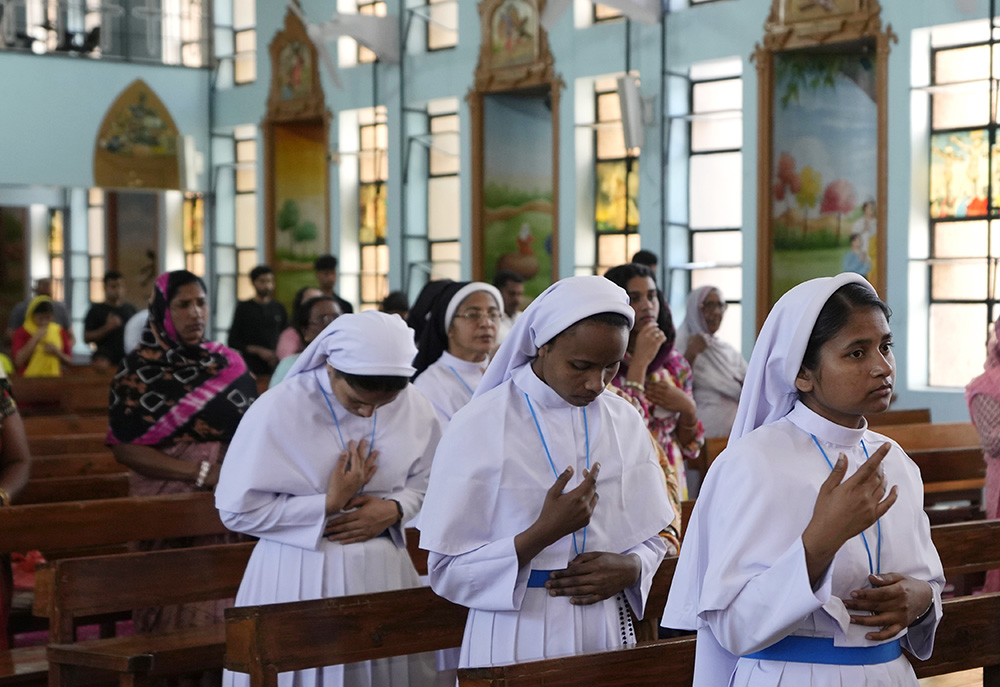
Catholic nuns attend a Mass at a church on Easter Sunday in Jammu, India, April 9. (AP/Channi Anand)
As in the West, even in India the average age of consecrated women seems to be increasing. I write this because of the stark difference between what I observed three to four decades ago and what I see today on my visits to the same institutes in western parts of my country.
It's also not uncommon anymore to see senior and retired sisters living together and continuing with some smaller project — a shift from the multigenerational communities of the past.
Vocations are rumored to be decreasing numerically as an effect of falling birthrates and smaller families, among several other possible factors. As I began some preliminary research on this, it was heartening to learn that Christians have the best sex ratio — 1,023 females to every 1,000 males — in a country where female feticide still isn't uncommon among people of other faiths. The girl child is seen as a liability among most Hindus.
According to a report published by Pew Research Center, in 2010 the population of Catholics in India was 10,570,000, which was 33.19% of the total number of Christians of various churches in the country. Thus, based on the given ratio, I would estimate that the population of male Catholics would be around 5,224,470, while that of females would be around 5,345,530 — which means there might be a difference of 121,060 females from various age groups. How would unmarried women of marriageable age respond to the unavailability of an equal number of Catholic bachelors?
I personally know several unmarried women who opted for consecrated life because they were unable to marry someone of their choice from another religion. I wonder whether this could impact the quality of vocations too? This is because my friends in various institutes often comment on generational differences with the buzzword "www," meaning, "When we were…"
So why do various age groups of women seem to display varying degrees of seriousness and commitment to their vocation and mission, according to them? Is what they say true?
To find an answer, I glanced through a table from the 2011 census, which shows the numbers of Christian males and females in various age groups in rural and urban parts of India. Although the overall number of females is more than males in both rural and urban contexts, I was shocked to see that the sex ratio of females to males has been showing a decreasing trend, over the decades, especially in rural areas, like it is among Hindus. This is specifically seen in the age groups of 0-19 years, with a higher number of male Christians.
Advertisement
Now in 2023, these same persons would be included in the age group of 12-31 years, which could explain the numerical decline in women's vocations over the last decade. It would be interesting to see whether, by contrast, men's vocations to priesthood or religious life have increased, since they would either need to find a Christian partner from another country, or consider interreligious marriage, or choose a celibate life path.
Moreover, regardless of their gender, if a person opts for consecrated life and/or ordained life out of frustration from being unable to find a suitable marriage partner, it could be a red flag!
On a happy note, however, the new women entrants to consecrated life who opted for the celibate life path — despite the availability of a higher number of young bachelors — could be expected to be more serious and committed. So I think my friends should avoid generalizing about the commitment of the newer members in their institutes! Let's take our own lives more seriously.
Back to that table from the 2011 census: I discovered that the age groups from 20-39 show a widening gap in the numbers, with more females, but the difference narrows down in the 40-plus age groups. The 80-plus group once again shows an increase in females.
Perhaps these figures are an outcome of migration of young adult male members of families to other countries for work opportunities. I don't know whether they were included in the population census or not. Also, perhaps the life expectancy of females above 80 years is higher than that of males.
Demographic changes are seen as vocations are flourishing in previously untapped and economically challenged communities in certain parts of the country, while they are almost disappearing in previously fertile fields. This needs to be considered along with the impact of the sex ratio.
Of course, we cannot ignore sociological factors contributing to the rise or decline in vocations to consecrated and/or ordained life. But isn't vocation basically "God's call"?
As I was writing this column, I received this message on Twitter from Pope Francis: "The Holy Spirit keeps faith ever young. He does not bind Himself to passing epochs or trends, but brings the relevance of Jesus, risen and living, into our world today." That is worth reflecting upon!




